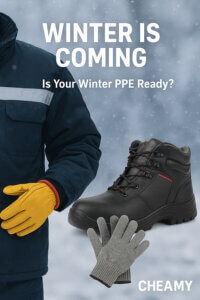As temperatures drop, ensuring your workforce is equipped with the right PPE for winter is essential to maintaining safety and productivity. At CHEAMY, our mission is to redefine PPE by merging comfort and high-quality protection. In this guide, we’ll discuss our core values, industry-specific PPE needs, tips for selecting winter-ready gear, and best practices for compliance.
Why Winter PPE is Essential for Cold-Weather Safety
Working in cold environments presents unique challenges, including an increased risk of cold stress conditions such as hypothermia and frostbite. Data from the Bureau of Labor Statistics (BLS) highlights a spike in cold-related injuries during winter months, particularly slips, trips, and falls on icy surfaces. For instance, in 2019, BLS reported that over 20% of workplace injuries in cold environments were due to falls, making proper winter PPE indispensable.
Winter PPE should protect from cold stress and environmental hazards while maintaining comfort to encourage consistent wear.
Encouraging Winter PPE Compliance Among Employees
Compliance is a significant factor in workplace safety. If PPE is uncomfortable, workers are less likely to wear it consistently. Here are some effective strategies to ensure your team embraces winter PPE:
- Educate: Provide training that emphasizes the importance of PPE, particularly in preventing cold-related illnesses and injuries.
- Involve Employees in Selection: Allow employees to try out different PPE options to identify gear that fits comfortably.
- Lead by Example: Management should model correct PPE usage to set a strong example for the team.
- Provide Comfort-Driven Options: Equip workers with lightweight, breathable, and insulated options that they’ll actually want to wear.
With these steps, compliance becomes less of a challenge and more of a habit, creating a safer work environment.
Industry-Specific Winter PPE Recommendations
Different industries face varying winter risks, making it essential to choose PPE tailored to specific needs. Here’s a breakdown:
- Construction: Construction workers benefit from insulated helmets, thermal gloves, and boots with slip-resistant soles to reduce fall risks. High-visibility gear is also essential in low-light conditions.
- Manufacturing: Layers are crucial, especially thermal base layers and hand protection to prevent dexterity loss. Waterproof and slip-resistant footwear is also critical.
- Healthcare: Winter PPE includes warm, non-slip footwear and insulated coats for outdoor duties. PPE should also be easy to sanitize to meet hygiene standards.
- Agriculture: Thermal clothing, waterproof boots, and protective gloves are essential. Farmers and outdoor workers in rural areas often face extreme weather, so layers and wind-resistant clothing are recommended.
Matching PPE to specific industry needs helps ensure that each team receives the right balance of protection and comfort.
Choosing Winter PPE that Balances Comfort and Compliance
Selecting winter PPE that balances comfort and compliance ensures workers wear the equipment as intended. CHEAMY offers the following considerations for choosing winter PPE:
- Material: Opt for lightweight, breathable materials that provide warmth without causing overheating.
- Ergonomic Fit: A good fit allows for easy movement, reducing fatigue and improving productivity.
- Advanced Insulation: Insulated gloves, jackets, and headgear that trap heat without adding excessive bulk are ideal for long workdays.
- Anti-Slip Footwear: Icy surfaces pose a major hazard in winter, so slip-resistant boots with good insulation are essential.
At CHEAMY, we create PPE that combines all these factors, so workers don’t have to choose between safety and comfort.
Real Stories: Safety Meets Comfort in Action
Many workers have shared how CHEAMY’s PPE has changed their experience at work. A construction crew in the Midwest recently reported that our insulated helmets and thermal gloves made it easier to work in sub-zero temperatures, improving morale and reducing the likelihood of accidents. These real-life stories confirm that our approach to comfort-driven PPE makes a difference in workers’ lives, even during winter’s toughest conditions.
CHEAMY’s Core Values: Innovation, Quality, and People-Centric Design
At CHEAMY, we believe that effective PPE should prioritize not only safety but also comfort. This commitment drives our core values:
- Innovation: Our team constantly pushes the boundaries in design to integrate advanced safety features with optimal comfort.
- Quality: We ensure each product is crafted to meet international safety standards, with durability and usability as top priorities.
- People-Centric Design: We focus on understanding the real challenges of the workforce, creating PPE solutions that empower and protect without compromising comfort.
Our design principles come together to offer PPE that enhances safety while making it something workers are comfortable wearing all day. Now let’s look at how this philosophy applies to choosing winter PPE that truly meets the demands of cold weather conditions.
Winter PPE Maintenance Tips
Proper care and maintenance extend the life of PPE and ensure it performs effectively. Here are some winter-specific tips:
- Inspect Regularly: Check gloves, boots, and helmets for any signs of wear and tear.
- Keep Dry: Damp PPE loses its insulation properties. After each shift, dry out any wet items thoroughly.
- Clean Routinely: Regularly clean PPE, particularly if exposed to snow, salt, or grime, which can degrade materials.
A maintenance routine helps ensure that PPE remains effective, safe, and comfortable throughout the winter season.
Conclusion: Prepare Your Team for a Safe Winter with CHEAMY
Winter presents unique challenges, but with the right PPE, your workforce can tackle the season safely and comfortably. At CHEAMY, our commitment to quality, innovation, and people-centric design ensures that every product we offer balances protection with comfort. Equip your team for winter with PPE that makes a difference—choose CHEAMY and experience the harmony of safety and comfort.








